
Social media has become integral to our daily lives, shaping the way we interact and seek validation from others. Since the introduction of the ‘like’ button on Facebook in 2009, users have received ‘likes’ and ‘hearts’ as signs of approval. This simple tool enables users to give and receive immediate, quantifiable feedback (Oremus, 2022). Initially symbolised by the iconic ‘thumbs-up’ icon, it has been widely adopted by other platforms, such as Instagram, where users tap a heart to show their appreciation.
The accumulated number of likes on a post can boost our confidence, foster a sense of belonging, and keep us coming back for more (Burrow & Rainone, 2017; Smith et al., 2021). However, the validation from those little hearts can also encourage excessive social media use, and when the likes stop coming, it can leave us feeling rejected and lower our self-esteem (Timeo et al., 2020). Adolescence is a developmental period characterised by heightened sensitivity to both rewards and rejection (Quarmley et al., 2019; Shulman et al., 2016). This leaves the question of whether adolescents, more so than adults, are particularly sensitive to receiving this type of social feedback on social media.
Taking a computational approach, this recent study by Ana da Silva Pinho and colleagues (2024), published in Science Advances, seeks to answer this question using a comprehensive set of methods and data.

No likes? The researchers investigated how receiving more or fewer likes influenced online engagement and mood.
Methods
The researchers investigated sensitivity to social media feedback across three studies.
Study 1 analysed Instagram trace data from adolescents (ages 13 to 19) and adults (ages 30-39). The data, which was originally collected between 2014 – 2015, included 1.72 million Instagram posts from 7,718 adolescents and 8,895 adults. The data consisted of users’ activities, such as the number of posts, timestamps, and the number of likes. The researchers built a computational model to understanding online engagement. According to this reinforcement learning model, a person’s online engagement, or how often they post on social media, operates as a function of how many likes they receive: the more likes, the sooner the person will post again. The model also incorporates the effort cost that is involved in posting, such as opening the app and creating content, and this will ultimately set a limit to how often someone can post.
Study 2 employed an online experiment mimicking Instagram, where 92 adolescents (ages 16 to 20) and 102 adults (ages 30 to 40) posted memes under a high-reward (receiving 28-34 likes per post) and a low-reward (receiving 6-18 likes per post) condition. Real-time feedback (likes) was visible for posted memes. The participants’ mood was measured at three timepoints; before the experiment, between the two conditions, and after the experiment.
Study 3 combined historical Instagram trace data, self-reports of social anxiety and problematic social media use, in addition to structural brain imaging data. Magnetic resonance imaging (MRI) scans were available from 96 emerging adults (ages 18-24). A computational learning model was fitted to the Instagram trace data to estimate learning rates.
Results
Study 1 – likes matter
Using a large dataset of Instagram posts and applying a computational learning model, the researchers found that adolescents showed a 44% higher learning rate compared to adults. The higher learning rate among adolescents, referring to how quickly individuals adapt their posting behaviour in response to likes received on Instagram, indicates that their social media engagement is more strongly motivated by their response to social feedback compared to adults. Contrary to the researchers’ hypothesis, the adolescents did not show a lower effort cost. As adolescents are thought to be digitally superior to adults, the researchers anticipated that adolescents’ posting behaviour would also reflect their lower effort in posting, referring to opening the app and creating content. In sum, adolescents’ social media posting behaviours seem to be more strongly influenced by increases and decreases in the number of likes they receive, compared to adults.
Study 2 – likes affect mood
In the experimental study, comparing situations where adults and adolescents received more (high-reward) or fewer (low-reward) likes, the results showed that adolescents displayed greater fluctuations in their mood when they experienced shifts in number of likes received. Specifically, both groups of participants experienced increased positive mood in the high reward condition, but the adolescents experienced greater mood declines when they started to receive fewer likes. Adolescents also ended the experiment with a more negative mood compared to adults. The results revealed no difference in the time it took to post (posting latency) and generally, adolescents posted less frequently overall. These findings were independent of self-reported problematic social media use or social anxiety levels.
Study 3 – brain regions
In the third study, the researchers applied an exploratory neuroimaging approach. The participants also provided Instagram trace data, with an average 5.74 years of use. The aim was to examine long-term effects of social media use and social media feedback on the brain. The study identified several brain regions associated with social feedback sensitivity, all which are known to be important for basic feedback processing, including the amygdala, ventral diencephalon, pallidum, and putamen. The amygdala, known for its key role in emotion processing, was also found to be associated with social media sensitivity, social anxiety, and problematic media use.

Young people are considered digitally superior to adults. However, this did not influence posting behaviour. More so than adults, adolescents adjusted their online engagement based on the number of likes they received.
Conclusions
Overall, the results support the hypothesis that adolescence is a developmental period characterised by heightened sensitivity to social media feedback, such as likes. Compared to adults, adolescents are more likely to adjust their posting behaviours based on the number of likes they receive. This sensitivity is also reflected in greater mood fluctuations, with adolescents experiencing more negative mood changes when they receive fewer likes. Structural brain imaging data further support this finding, showing that specific brain regions, such as the amygdala, are involved in this heightened sensitivity.
Strengths and limitations
A key strength of the study is its focus on developmental sensitivity by comparing adults to adolescents, which has been highlighted as an important perspective in the social media literature (Orben et al., 2022). Another strength is that the researchers applied a wide variety of methodological approaches and data sources, including objective Instagram trace data, experimental evidence, and brain imaging data. Together, this provides a multidimensional understanding of social feedback across developmental stages.
The reliance on self-report measures of social media use and engagement has been a limitation of current research (Hodes & Thomas, 2021), which the current study overcomes. Also, rather than focusing on broad conceptualisations of social media use (e.g., time spend on social media), the researchers zoom in on a specific aspect of social media, namely receiving likes on Instagram. A related limitation is, however, that Instagram is a specific platform, and the generalisability of the results to other platforms needs to be examined further. While the researchers selected the platform based on its popularity across adolescent and adult populations, generational differences may still be present in the way adolescents versus adults interact with the platform (e.g., what type of content they post). Also, as the researchers highlight themselves, although receiving likes is a key affordance across many social media platforms, other types of feedback, such as comments or messages, may add to the complexity of real-world social media feedback and should be investigated further.
Personally, I found it a bit difficult to gain a clear understanding of the characteristics of the samples included in the studies, impeding my ability to evaluate the generalisability of the results to other populations and contexts. The researchers state that participants were recruited to the experimental study from English-speaking countries via social media, but I think the study would have benefitted from a demographics table for all the samples included in the study. This would also help clarify the distinct developmental periods that are investigated across the three studies. It should also be noted, that while this study has added to the totality of the findings, the small sample size (N < 100) included in the brain imaging study is limited with regards to generalisability.

Digital environments are complex, and future research may need to consider the multiple ways one can receive feedback on social media platforms, including messages and reactions.
Implications for practice
This study contributes to the social media literature by employing a variety of methods to explore adolescents’ sensitivity to social media feedback. The findings indicate that adolescents are particularly sensitive to receiving more or fewer likes on social media, suggesting that how many likes they receive can influence their posting activity. Receiving fewer likes in the experimental condition was also associated with reports of greater mood declines among adolescents.
The research provides a valuable step in understanding how young people are impacted by social media feedback, but it remains unclear whether receiving more or fewer likes is exclusively positive or negative. On one hand, the results suggest that more likes can lead to increased social media engagement, which may further contribute to excessive use – a potentially harmful effect. On the other hand, fewer likes might reduce posting engagement, which could be perceived as a positive outcome. The current study highlighted, however, that the latter is also associated with mood declines.
For me, one question that arises after reading the paper is how receiving social media feedback might influence other online behaviours. For example, while the results suggest that receiving more likes increases posting behaviour, could receiving fewer likes lead to greater passive social media use, such as scrolling through others’ profiles instead of actively posting content? A reduction in posting behaviour does not necessarily equate to reduction in overall social media activity.
For professionals working with adolescents, I think a key takeaway is that youths’ sensitivity to rejection and social feedback extends to the online world. Facilitating meaningful conversations about social media use, such as discussing how likes, comments, or messages influence their well-being and mental health, can provide valuable opportunities to support young people in navigating digital environments.
Another practical implication deriving from this study is the need for age-appropriate policies and strategies in the design of social media platforms. One avenue highlighted by the researchers themselves is to reduce the emphasis on likes. For example, Instagram allows users to hide likes on their personal accounts. Educating young people about this and related features could prove beneficial in reducing the negative effects of social media use on their mood and behaviour.

There is a need for age-appropriate policies and strategies in the design of social media platforms to help reduce the negative effects of social media use on young people’s mood and behaviour.
Statement of interests
No conflict of interests to declare.
Links
Primary paper
da Silva Pinho, A., Céspedes Izquierdo, V., Lindström, B., & van den Bos, W. (2024). Youths’ sensitivity to social media feedback: A computational account. Science Advances, 10(43), eadp8775. https://doi.org/10.1126/sciadv.adp8775
Other references
Burrow, A. L., & Rainone, N. (2017). How many likes did I get?: Purpose moderates links between positive social media feedback and self-esteem. Journal of Experimental Social Psychology, 69, 232–236. https://doi.org/10.1016/j.jesp.2016.09.005
Hodes, L. N., & Thomas, K. G. F. (2021). Smartphone Screen Time: Inaccuracy of self-reports and influence of psychological and contextual factors. Computers in Human Behavior, 115, 106616. https://doi.org/10.1016/j.chb.2020.106616
Orben, A., Przybylski, A. K., Blakemore, S.-J., & Kievit, R. A. (2022). Windows of developmental sensitivity to social media. Nature Communications, 13(1), 1649. https://doi.org/10.1038/s41467-022-29296-3
Oremus, W. (2022). 21. The Curse of the Awesome Button. In T. Bosch (Ed.), “You Are Not Expected to Understand This”: How 26 Lines of Code Changed the World (pp. 131–138). Princeton University Press. https://doi.org/10.1515/9780691230818-023
Quarmley, M. E., Nelson, B. D., Clarkson, T., White, L. K., & Jarcho, J. M. (2019). I Knew You Weren’t Going to Like Me! Neural Response to Accurately Predicting Rejection Is Associated With Anxiety and Depression. Frontiers in Behavioral Neuroscience, 13, 219. https://doi.org/10.3389/fnbeh.2019.00219
Shulman, E. P., Smith, A. R., Silva, K., Icenogle, G., Duell, N., Chein, J., & Steinberg, L. (2016). The dual systems model: Review, reappraisal, and reaffirmation. Developmental Cognitive Neuroscience, 17, 103–117. https://doi.org/10.1016/j.dcn.2015.12.010
Smith, D., Leonis, T., & Anandavalli, S. (2021). Belonging and loneliness in cyberspace: Impacts of social media on adolescents’ well-being. Australian Journal of Psychology, 73(1), 12–23. https://doi.org/10.1080/00049530.2021.1898914
Timeo, S., Riva, P., & Paladino, M. P. (2020). Being liked or not being liked: A study on social-media exclusion in a preadolescent population. Journal of Adolescence, 80, 173–181. https://doi.org/10.1016/j.adolescence.2020.02.010
Photo credits
- Photo by Qim Manifester on Unsplash
- Photo by Prateek Katyal on Unsplash
- Photo by Charles Deluvio on Unsplash
- Photo by George Pagan III on Unsplash
- Photo by Eliott Reyna on Unsplash
